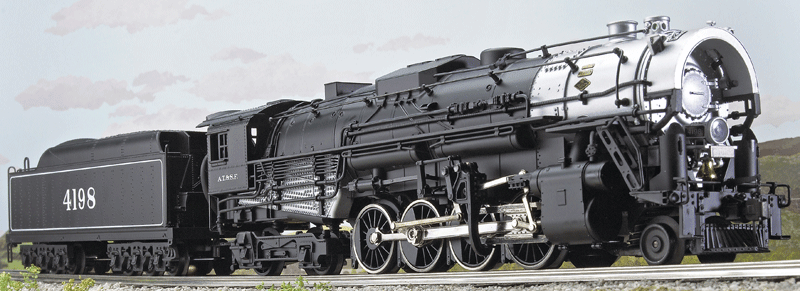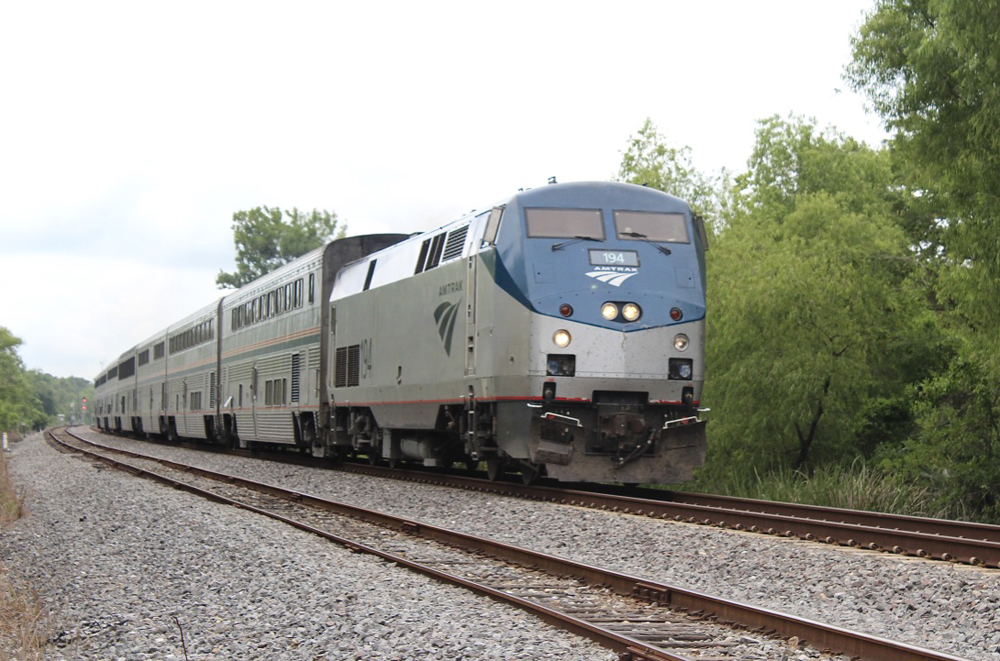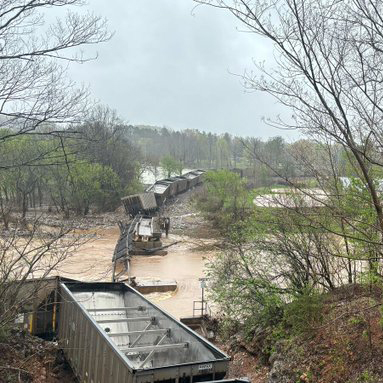Alas, K-Line went out in a blaze of litigation, debt, and innovative model railroad products. Only time will tell how the K-Line brand will fare under control by the Chinese manufacturer Sanda Kan and subsequent licensing to Lionel.
One of the last large locomotives cataloged by K-Line was its Lima 2-8-4 Berkshire. Our sample is a well-crafted rendering of an early (1928) example of Super-Powered steam by Lima.
Super-Power was the slogan adopted by the Lima, Ohio, firm for its steam locomotives that set tonnage records through their superior capability for efficient water evaporation and coal burning (reducing the amount of coal consumption).
The 2-8-4 wheel arrangement derived its nickname “Berkshire” after Lima tested the prototype A-1 on the Boston & Albany line through the Berkshire Mountains of New England.
The model
Based on a Boston & Maine T-1a-class Berkshire, K-Line’s model features a distinctive Coffin feedwater heater, unusually shaped as a semi-circular hood suspended above the smokebox. While this is the most distinctive visual element of the model, to be honest, I found that the feedwater heater- no matter how accurately rendered – creates one of the most spud-ugly O gauge locomotives I’ve seen. Not even ugly in a manly sort of way, but plain old ugly.
The front of this steamer looks nothing if not business-like. Setting aside the esthetic shortcomings of the overhanging feedwater heater, the pilot has plenty of seam and rivet detail and a scale-sized dummy coupler with simulated uncoupler bar and chain.
The headlight, number board, and bell are located low, just above the coupler. Looking square on, you’ll see loads of rivet and hatch detail, along with compressor shields, grab irons, and twin marker lights topside.
The long boiler has some pretty distinct design work, including a significant number of add-on pipes, an industrial-strength sand dome, and builder’s and trust plates. You’ll find two smokestacks, a main and auxiliary (though the smoke unit flows the white stuff through the main stack only). Also on the top of the boiler are an add-on whistle, three pop-off valves, and a turbine. Handrails run the length of the boiler and above the windows.
If the locomotive looks good on top, the details below the running board are even better. There, you’ll find pipes galore, especially around the bottom of the firebox. In addition, the running gear is first rate and the trailing truck is a gem.
The side rods and drive wheels are chemically darkened, though they can still reflect quite a bit of light.
The cab has backhead detail as well as two crew figures. It also features an opening cab roof hatch, interior illumination, and firebox glow.
The locomotive has two pickup rollers approximately 3 inches apart, and the tender has two rollers approximately 6 inches apart. Slide switches for TrainMaster Command Control program/run, smoke, and speed-control are located on the underside of the locomotive, beneath the firebox and cab.
The metal tender is a six-axle rig with a cast-in coal load and a backup light. Flip up the water hatch and you can see the volume control and a selector switch to choose between RailSounds or just a whistle. There is a coil coupler mounted on the rear of the tender.
Painting and decoration on our Santa Fe model are very good. Both the black and the silver paint were neatly applied in a satin finish. The Santa Fe bought these locomotives second-hand from the Boston & Maine. As with the prototype, the railroad’s initials are affixed to the cab sides. The B&M logo was painted over (retaining the B&M’s white outline on the tender side), and the engine number was painted on three sides of the tender.
On the test track
This Berkshire has personality – some bad and some good.
Our sample steamer’s starts could be rough (with speed control either on or off), and on more than one occasion the locomotive opted to ignore commands from the Lionel CAB-1 controller altogether. Even in conventional-control mode, acceleration from a stop at times was a little rough, lurching a bit as the locomotive passed thorough different speed ranges.
Overall, though, the Berkshire was a satisfactory model to operate, despite the notchy throttle.
On the good side, the steamer had a very wide speed range and solid pulling power. My low-speed test average was 8.4 scale mph, and the high-speed average was 77.9 scale mph. Drawbar pull for the locomotive was an even 2 pounds.
The sound package was satisfactory, although at lower volume levels the various squeaks and metal-in-motion sounds of the locomotive overwhelmed the basic RailSounds package.
K-Line’s speed-control system in our sample Berkshire was just OK. In command-control mode, it was effective but with a touch of jittery behavior. In conventional-control mode, it was notchy, but mainly at lower speeds.
Berkshires, even one as unique as this B&M prototype, stand out in any O gauge roster. With a boiler front you’ll either love or hate, steam fans should look for this, the final large locomotive cataloged by K-Line during Maury Klein’s tenure at the helm, on hobbyshop shelves quickly before they’re all gone.
Price: $899.95 (no. K3699-4023CC with Lionel TrainMaster and RailSounds systems) or $749.95 (no. K3699-4023W)
Features: Scale size, TrainMaster Command Control, RailSounds, and K-Line Cruise Control
Pros: Captures the brute look of the prototype, high level of detail and features
Cons: Notchy cruise control, ability to get long-term parts and service is uncertain
Made in the People’s Republic of China















I have the demonstrator version of this engine and it is an excellent model and a strong runner. I hope that Lionel has thought about stocking parts for K Line trains.